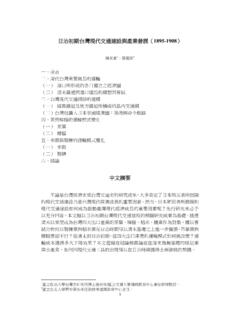Transcription of Development TWELFTH EDITION Michael P. Todaro …
1 economic Development TWELFTH EDITION Michael P. Todaro New York University Stephen C. Smith The George Washington University PEARSON Harlow, England London New York Boston San Francisco Toronto Sydney Auckland Singapore HongKong Tokyo Seoul Taipei New Delhi CapeTown S o Paulo Mexico City Madrid Amsterdam Munich Paris Milan Brief Contents Part One Principles and Concepts 1 1 Introducing economic Development : A Global Perspective 2 2 Comparative economic Development 40 3 Classic Theories of economic growth and Development 118 4 Contemporary Models of Development and Underdevelopment 164 Part Two Problems and Policies: Domestic 215 5 Poverty, Inequality, and Development 216 6 Population growth and economic Development : Causes, Consequences, and Controversies 284 7 Urbanization and Rural-Urban Migration: Theory and Policy 330 8 Human Capital.
2 Education and Health in economic Development 382 9 Agricultural Transformation and Rural Development 437 10 The Environment and Development 490 11 Development Policymaking and the Roles of Market, State, and Civil Society 541 Part Three Problems and Policies: International and Macro 599 12 International Trade Theory and Development Strategy 600 13 Balance of Payments, Debt, Financial Crises, and Stabilization Policies 678 14 Foreign Finance, Investment, Aid, and Conflict: Controversies and Opportunities 731 15 Finance and Fiscal Policy for Development 781 Contents VAVA AVAV Case Studies and Boxes Preface xix Part One Principles and Concepts 1 Introducing economic Development : A Global Perspective Prologue: An Extraordinary Moment How the Other Half Live Economics and Development Studies The Nature of Development Economics 9 Why Study Development Economics?
3 Some Critical Questions 11 The Important Role of Values in Development Economics 14 Economies as Social Systems: The Need to Go Beyond Simple Economics 15 What Do We Mean by Development ? Traditional economic Measures 16 The New economic View of Development 17 Amartya Sen's "Capability" Approach 18 Development and Happiness 21 Three Core Values of Development 22 The Central Role of Women 24 The Three Objectives of Development 24 The Future of the Millennium Development Goals Conclusions Case Study 1: Progress in the Struggle for More Meaningful Development : Brazil Comparative economic Development Defining the Developing World Basic Indicators of Development .
4 Real Income, Health, and Education Purchasing Power Parity 45 Indicators of Health and Education 49 Holistic Measures of Living Levels and Capabilities The New Human Development Index 51 Characteristics of the Developing World: Diversity within Commonality Lower Levels of Living and Productivity 57 Lower Levels of Human Capital 59 Higher Levels of Inequality and Absolute Poverty 60 Higher Population growth Rates 63 2 2 4 9 16 24 28 30 40 42 45 51 55 Vll viii Contents Greater Social Fractionalization 64 Larger Rural Populations but Rapid Rural-to-Urban Migration 65 Lower Levels of Industrialization and Manufactured Exports 66 Adverse Geography 67 Underdeveloped Markets 69 Lingering Colonial Impacts and Unequal International Relations 70
5 How Low-Income Countries Today Differ from Developed Countries in Their Earlier Stages 73 Physical and Human Resource Endowments 74 Relative Levels of Per Capita Income and GDP 75 Climatic Differences 75 Population Size, Distribution, and growth 75 The Historical Role of International Migration 76 The growth Stimulus of International Trade 78 Basic Scientific and Technological Research and Development Capabilities 79 Efficacy of Domestic Institutions 79 Are Living Standards of Developing and Developed Nations Converging?
6 80 Long-Run Causes of Comparative Development 85 Concluding Observations 93 Case Study 2: Comparative economic Development : Pakistan and Bangladesh 96 Appendix The Traditional Human Development Index (HDI) 112 3 Classic Theories of economic growth and Development 118 Classic Theories of economic Development : Four Approaches 119 Development as growth and the Linear-Stages Theories 119 rostow ' s stages of growth 120 The Harrod-Domar growth Model 121 Obstacles and Constraints 123 Necessary versus Sufficient Conditions.
7 Some Criticisms of the Stages Model 123 Structural-Change Models 124 The Lewis Theory of economic Development 124 Structural Change and Patterns of Development 129 Conclusions and Implications 130 The International-Dependence Revolution 131 The Neocolonial Dependence Model 131 The False-Paradigm Model 133 The Dualistic- Development Thesis 133 Conclusions and Implications 134 The Neoclassical Counterrevolution: Market Fundamentalism 135 Challenging the Statist Model: Free Markets, Public Choice, and Market-Friendly Approaches 135 Traditional Neoclassical growth Theory 137 Conclusions and Implications 139 Classic Theories of Development : Reconciling the Differences 140 Case Study 3: Schools of Thought in Context.
8 South Korea and Argentina 142 Appendix Components of economic growth 149 Appendix The Solow Neoclassical growth Model 155 Appendix Endogenous growth Theory 159 Contents ix 4 Contemporary Models of Development and Underdevelopment 164 Underdevelopment as a Coordination Failure 165 Multiple Equilibria: A Diagrammatic Approach 168 Starting economic Development : The Big Push 174 The Big Push: A Graphical Model 176 Other Cases in Which a Big Push May Be Necessary 181 Why the Problem Cannot Be Solved by a Super-Entrepreneur 182 Further Problems of Multiple Equilibria 183 Inefficient Advantages of Incumbency 183 Behavior and Norms 184 Linkages 185 Inequality, Multiple Equilibria.
9 And growth 186 Michael Kremer's O-Ring Theory of economic Development 187 The O-Ring Model 187 Implications of the O-Ring Theory 190 economic Development as Self-Discovery 192 The Hausmann-Rodrik-Velasco growth Diagnostics Framework 193 Conclusions 197 Case Study 4: Understanding a Development Miracle: China 200 Problems and Policics: Domestic 215 Poverty, Inequality, and Development 216 Measuring Inequality 218 Size Distributions 218 Lorenz Curves 220 Gini Coefficients and Aggregate Measures of Inequality 222 Functional Distributions 224 The Ahluwalia-Chenery Weifare Index (ACWI) 225 Measuring Absolute Poverty 226 Income Poverty 226 Poverty, Inequality, and Social Weifare 230 What's So Bad about Extreme Inequality?
10 230 Dualistic Development and Shifting Lorenz Curves: Some Stylized Typologies 232 Kuznets's Inverted-U Hypothesis 235 growth and Inequality 239 Absolute Poverty: Extent and Magnitude 240 The Multidimensional Poverty Index (MPI) 242 growth and Poverty 248 economic Characteristics of High-Poverty Croups 250 Rural Poverty 250 Women and Poverty 251 Ethnic Minorities, Indigenous Populations, and Poverty 255 X Contents Policy Options on Income Inequality and Poverty: Some Basic Considerations 256 Areas of Intervention 256 Altering the Functional Distribution of Income through Relative Factor Prices 257 Modifying the Size Distribution through Increasing Assets of the Poor 258 Progressive Income and Wealth Taxes 260 Direct Transfer Payments and the Public Provision of Goods and Services 260 Summary and Conclusions: The Need for a Package of Policies 262 Case Study 5: Institutions, Inequality, and Incomes.













